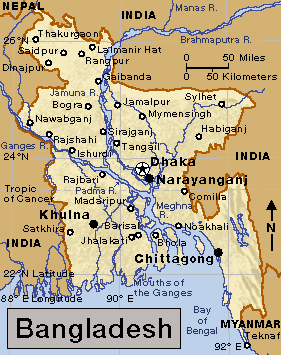Just over a century ago, in 1913, the winner of the 13th Nobel Prize in literature was Rabindranath Tagore, a writer from the historic region of Bengal in northeastern India. Tagore wrote mainly in Bengali, his native language, and his poems, songs, plays, stories, and essays were part of a long legacy of influential literature in the language. Tagore’s writings called for unity, peace, and freedom among all people. He also supported independence for India, which was then ruled by the United Kingdom. Tagore was the first non-European writer to win the Nobel Prize in literature.
Tagore’s language, Bengali, is one of the main languages of South Asia. Today, about two-thirds of all Bengali speakers live in the densely-populated nation of Bangladesh, where the language is called Bangla.Bangladesh means Bengal nation. Most other Bengali speakers live across Bangladesh’s western border in West Bengal, a state in northeastern India. In the past, West Bengal and Bangladesh were part of the single historical region of Bengal.
Today, Bengali is one of the most widely spoken languages in the world. According to some estimates, more than 240 million people speak it as their primary language.

Bengali is part of the huge Indo-European language family that includes many European languages, Persian, and several major languages of India. Within this family, Bengali belongs to the Indo-Aryan branch, which also includes Hindi and Urdu. Like Hindi and Urdu, Bengali developed from the ancient Indian language Sanskrit, which dates back at least 3,000 years. The earliest known examples of Bengali are a collection of sacred Buddhist songs that were written down around 1,000 years ago.
The Bengal region has been ruled by many empires and peoples, including Buddhists, Hindus, and Muslims. In the 1700’s and 1800’s, Bengal became the political and economic center of British rule in India. During the late 1800’s and early 1900’s, Tagore and other Bengali writers were at the forefront of the struggle for Indian independence.
India became independent in 1947, but it was divided into two parts—and so was Bengal. West Bengal, which is mostly Hindu, remained part of India. East Bengal, which is mostly Muslim, was combined with the northwestern corner of India, also mostly Muslim, to form the nation of Pakistan.
Cultural and economic differences divided East Bengal (renamed East Pakistan) and West Pakistan, however. Language was one of the major issues. The people in West Pakistan spoke several languages, and their leaders hoped that the main one, Urdu, could become a unifying influence in the country. East Pakistanis wanted to keep their own language, Bengali, and they resented attempts to make Urdu their official language. Several Bengali poets of the 1950’s and 1960’s became defenders of Bengali language and culture. In 1971, resentments on a number of issues boiled over into civil war. East Pakistanis declared independence and established Bangladesh.
Bengali speakers in both Bangladesh and West Bengal continue to identify closely and proudly with their language. The Bengali language has been one of the most influential elements in the region’s culture and history.
Untitled Document
Can't view the linked articles? Subscribe to World Book Online

World Book Online delivers a progressive sequence of core databases supported by supplemental
tools, such as language translation, graphic organizers, and unique Webquests. Moving from
Early World of Learning to World Book Advanced, World Book Online aligns end-users with their
appropriate learning levels. Each stand-alone site provides additional features to support the
needs of users’ specific capabilities.
The World Book Difference
World Book combines cutting-edge technology with traditional editorial excellence to produce
authoritative, trustworthy, and unbiased content. The digital content is updated in real time and
carefully curated for each learning level. Accessible 24/7, the content is available on a variety of devices.
World Book Online combines 21st-century instructional techniques with timely information.
By breaking down complex topics and using easily understandable text, World Book Online helps to
build fluency and increase comprehension. Featuring single sign-on capability, these sites are paired
with highly visual content to engage even the most reluctant reader. Our collection of resources kindles
a lifelong learning experience for every user. This adherence to clarity, currency, and accuracy makes
World Book’s digital offerings an information hub for the classroom, library, and beyond.
Image 1: Bangladesh flag. Credit: © T. Lesia, Shutterstock
Image 2: Bangladesh Credit: WORLD BOOK map